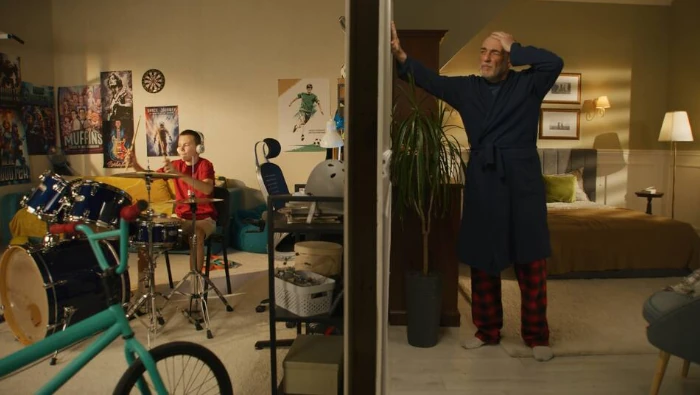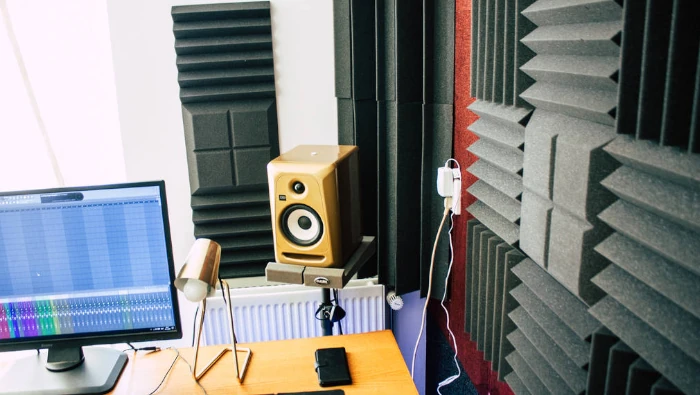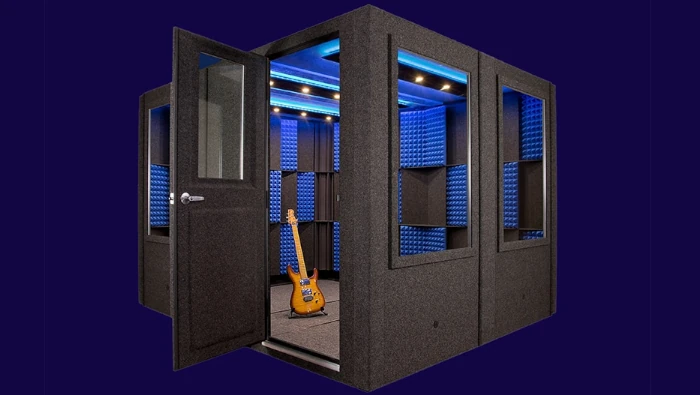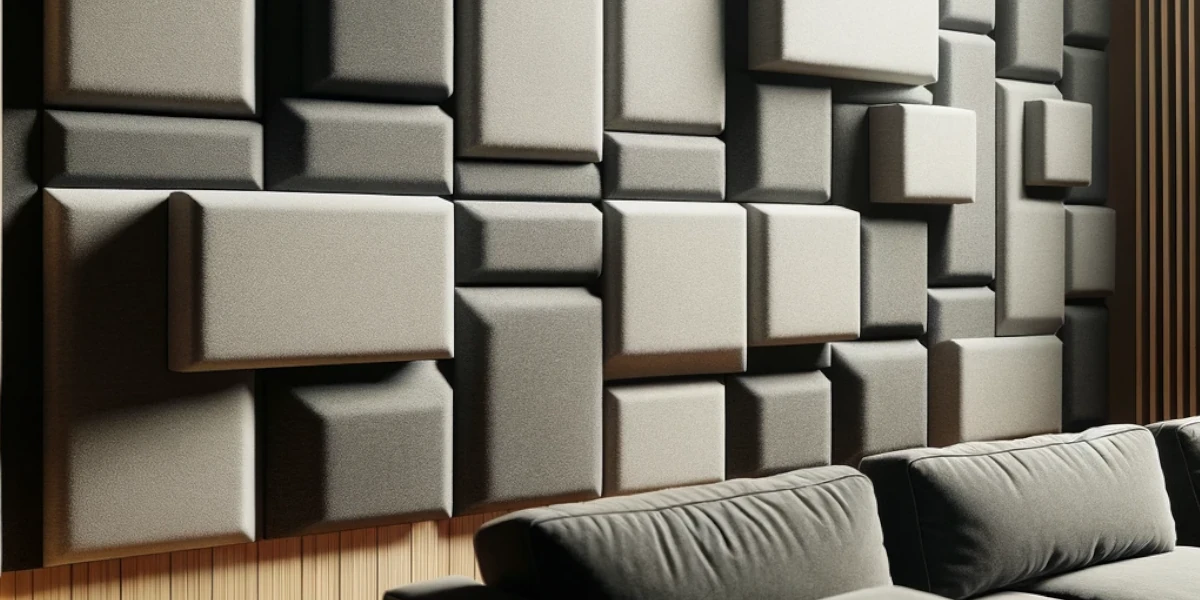In the heart of every musician’s home lies a sacred space where creativity meets sound—a home studio. Yet, the journey from melody to masterpiece isn’t just about the notes you play; it’s equally about the silence that surrounds them. This symphony of silence, a crucial component for any soundproof recording studio, is what transforms a simple room into a sanctuary of sound. Imagine being able to immerse yourself fully in your music without the slightest intrusion from the world outside. No cars honking, no dogs barking—just pure, unadulterated sound.
For neighbors and musicians alike, the harmony between living spaces and creative spaces is a delicate balance. The decision to embark on home studio acoustic insulation isn’t merely an investment in your music—it’s a gesture of goodwill to those around you, a commitment to peace that reverberates beyond your walls. As we peel back the layers of why acoustic insulation is indispensable for home studios, let’s dive into the essence of this symphony of silence. It’s not just about keeping the noise out; it’s about inviting the perfect sound in, ensuring every chord and note is captured exactly as intended, free from the cacophony of the outside world.
This introduction to home studio acoustic insulation is more than a starting point. It’s an invitation to explore how silence and sound coalesce, creating a haven for artists to craft their work in the best possible conditions. Let’s embark on this journey together, discovering how to achieve that pristine sound quality that every musician yearns for, all while fostering a harmonious relationship with our surroundings. The symphony of silence isn’t just about avoiding complaints or capturing a flawless take; it’s about creating music in its purest form, in a space that respects both the art and the artist.
The Problem: When Music Becomes Noise

Music, in its essence, is a form of expression that transcends words, capable of evoking deep emotions and creating bonds between people. However, when the strumming of a guitar, the beats of a drum, or the melody of a piano escapes the confines of a home studio and invades the personal space of neighbors, it transforms. What is music to one’s ears becomes noise to another’s. This clash of sound and silence is where the harmony of community living faces its greatest challenge.
The crux of the problem lies not in the music itself, but in the lack of acoustic insulation within home studios. Imagine the scenario: you’re deep into a recording session, pouring your soul into every note, unaware that the vibrancy of your music is becoming a source of irritation next door. Conversely, the everyday sounds of life—cars honking, dogs barking, and neighbors conversing—become unwelcome guests on your tracks. These intrusions are not merely distractions; they are interruptions that compromise the integrity of your work.
The Intrusion of Everyday Sounds
This issue is two-fold. On one side, musicians grapple with capturing the purity of their sound, striving for a clean recording free from the muddle of background noise. On the other, neighbors yearn for the tranquility of their homes, a peace disturbed by the unintended intrusion of sound. It’s a delicate balance, tipping easily towards frustration and conflict.
Moreover, this noise pollution does more than just strain neighborly relations; it impacts the musician’s creative process. The constant concern over volume levels and the potential for noise complaints stifles creativity, replacing the joy of music-making with anxiety and restraint. The essence of freedom in musical expression is lost, confined by the walls that fail to contain the sound.
The problem of when music becomes noise underscores the pressing need for effective home studio acoustic insulation. It’s about creating an environment where sound is not just produced but controlled and contained, allowing for artistic freedom without encroaching on the peace of others. This is the challenge that musicians and residents alike face—a challenge that calls for a harmonious solution.
The Solution: Home Studio Acoustic Insulation

The harmony between relentless creativity and peaceful coexistence lies in the art of acoustic insulation. Recognizing the transformative power of soundproofing is the first step towards cultivating an environment where every note played is a note meant to be heard, and only by those within the studio’s embrace. Home studio acoustic insulation isn’t just a technical fix; it’s a bridge to understanding, a testament to the respect musicians have for their craft and their community.
At its core, acoustic insulation is about controlling sound’s flow: keeping the music in and the world out. This control allows musicians to dive deep into their creative processes without fear of disturbing their neighbors or capturing unwanted ambient noise. Similarly, it ensures that the daily lives outside do not permeate the sanctity of the recording space. The result? A studio that’s both a haven for the artist and a good neighbor.
The Science of Silence: Understanding Acoustic Insulation
Implementing effective acoustic insulation involves understanding the science of sound. Sound travels not just through air but through any medium it encounters, including walls, floors, and ceilings. Thus, insulation techniques focus on breaking the path of sound, using materials and constructions that absorb and block these sound waves. The goal is straightforward: create a space where sound is a welcomed guest, confined within the walls of its home.
Several methods can achieve this isolation, each with its benefits and considerations. From constructing dense, sound-absorbing barriers to designing a “room within a room” for maximum isolation, the options are as varied as the needs of musicians themselves. These methods don’t just silence the studio; they enhance the quality of the sound captured, providing a clear, unblemished canvas for artists to paint their auditory masterpieces.
Choosing the right acoustic insulation method depends on several factors, including the studio’s location, the type of music being recorded, and budget constraints. Yet, regardless of the approach, the investment speaks volumes. It’s a declaration of commitment to one’s art, a nod to the importance of neighborly harmony, and a step towards professional-grade recordings.
Home studio acoustic insulation is more than a solution; it’s a declaration of independence for musicians. It liberates them from the constraints of noise pollution and neighborhood tensions, empowering them to explore the depths of their creativity at any hour, without reservation. This freedom is not just about making music; it’s about making music that’s true to the artist’s vision, unfettered by the world outside.
Method 1: Building Barriers
Embarking on the journey of acoustic insulation often leads to the construction of physical barriers—a method as effective as it is direct. This approach to soundproofing revolves around the principle of mass: the denser a barrier, the less sound can pass through it. For home studio enthusiasts seeking a long-term, robust solution, building solid walls represents a fortress of solitude for their musical endeavors.
The essence of this method lies in enhancing the studio’s structural integrity with materials known for their sound-blocking capabilities. Concrete, thick drywall, and special acoustic bricks are among the top choices for those ready to invest in a permanent shield against external noise. This approach isn’t just about adding layers; it’s about creating a seamless barrier that stands as a bulwark against the invasion of unwanted sounds.
However, the effectiveness of these barriers is not solely reliant on the materials used but also on the meticulousness of their installation. Sealing gaps, covering potential leak points, and ensuring airtight construction are crucial steps in the process. Every joint, every seam, and every intersection becomes a critical focal point, demanding attention to detail to prevent sound leakage.
The Long-Term Benefits of Structural Soundproofing
While building such barriers is an investment upfront, both in terms of time and finances, the payoff is a recording space that offers unparalleled sound isolation. The benefits extend beyond the immediate acoustic improvements. These structures can significantly enhance the studio’s overall sound quality, providing a controlled environment that’s conducive to capturing the pure essence of your music.
Moreover, the permanence of these barriers means a long-term return on investment. Not only do they serve to protect your creative space from external noise today, but they also add value to your property and its appeal, should your studio ever change hands.
Choosing to build barriers for your home studio acoustic insulation is a testament to your dedication to your craft. It’s a statement of intent, signaling a professional approach to sound management and a commitment to achieving the highest quality recordings possible. For those who view their music as not just a hobby but a life’s work, this method stands out as a beacon of excellence in soundproofing solutions.
Method 2: The Room Within a Room

For musicians and producers who seek flexibility alongside effective sound isolation, the “room within a room” method offers a harmonious solution. This innovative approach to acoustic insulation crafts a sanctuary of sound by constructing a secondary, independent structure within the existing room. The beauty of this method lies in its adaptability, allowing for significant soundproofing without the permanence or extensive modifications required by more traditional construction methods.
The essence of the “room within a room” concept is to create a physical buffer zone between the studio space and the external environment. By building a separate layer of walls, ceilings, and sometimes floors, you effectively decouple the studio from surrounding structures. This decoupling is key to minimizing sound transmission, as it reduces the points of contact through which sound waves can travel.
Materials used in this method often include specialized framing components, sound-absorbing insulation, and mass-loaded vinyl, all working together to dampen vibrations and contain sound. Additionally, the air gap created between the original room and the new structure acts as a natural insulator, further enhancing the sound-blocking capabilities of the studio.
Flexibility Meets Effectiveness: Adapting Your Space
One of the most appealing aspects of the “room within a room” method is its relatively non-invasive nature. It offers a compromise for those who cannot or prefer not to engage in heavy construction. Whether due to renting agreements, budget constraints, or simply the desire for a less permanent solution, this method provides a viable path to achieving professional-level sound isolation.
Moreover, this approach does not preclude the addition of acoustic treatments within the studio itself. Sound-absorbing panels, bass traps, and diffusers can all be incorporated to fine-tune the acoustic properties of the space, ensuring that the sound quality within the studio is as pristine as the silence that surrounds it.
In essence, the “room within a room” method is a testament to the ingenuity of modern soundproofing. It balances the need for effective acoustic insulation with the desire for flexibility, offering a solution that can be tailored to the unique needs and constraints of each home studio. For those who view their music creation space as a constantly evolving entity, this method stands as a beacon of adaptability and innovation in the quest for the perfect sound.
Timing is Everything: Recording Schedules

In the symphony of soundproofing strategies, the timing of your recording sessions emerges as a surprisingly simple yet profoundly effective technique. While structural modifications provide a solid foundation for acoustic insulation, aligning your recording schedule with the quietest hours in your environment adds another layer of sound control. This method, often overlooked, can be the key to achieving pristine recordings without a single note of noise pollution.
Understanding the rhythm of your neighborhood’s noise levels involves a bit of observation and planning. The goal is to identify those golden hours when the external world falls into a hush, offering a natural backdrop of silence for your studio. For many, these hours might be in the early mornings, when the hustle and bustle of daily life have yet to begin, or late at night, when the world has settled down.
Strategic Planning for Quieter Sessions
Adjusting your recording schedule to these quieter times doesn’t just minimize the likelihood of capturing unwanted sounds; it also reduces the pressure to constantly monitor and adjust for background noise. This peace of mind allows you, as an artist, to focus wholly on the creative process, secure in the knowledge that your recordings will be as clear and clean as the quiet outside.
Moreover, being mindful of your recording times shows a considerate approach to your neighbors. It’s a way of harmonizing your need for sound quality with the community’s need for peace, building goodwill and understanding. This mutual respect can often lead to a more supportive environment for your musical endeavors, with neighbors who are more accommodating of your passion.
Implementing this strategy doesn’t require any financial investment, yet its value is immense. It’s about leveraging the natural ebb and flow of sound in your surroundings to your advantage, turning time into a tool for acoustic insulation. By planning your recording sessions around the quietest periods, you effectively create a makeshift soundproofing solution that complements any structural measures you’ve taken.
In conclusion, while walls and materials work to keep unwanted sounds at bay, integrating strategic recording schedules ensures that the music you produce is as uninterrupted as possible. It’s a testament to the adage that sometimes, the simplest solutions are the most effective. By syncing your creative process with the silent beats of the day or night, you achieve a harmony that elevates your music to its highest potential, untouched by the noise of the world outside.
Conclusion: Harmony at Home and Beyond
As we draw the curtains on our exploration of home studio acoustic insulation, it’s clear that achieving harmony between sound and silence is an art form in itself. From constructing impenetrable barriers to designing a secluded room within a room, and aligning recording schedules with the quiet whispers of dawn or the deep calm of night, each method offers a unique path to the same destination: pristine sound quality in a peaceful coexistence with the world outside.
The journey towards perfecting your home studio doesn’t just enhance your music; it fosters a deeper respect for the delicate balance between pursuing your passion and maintaining the tranquility of your neighborhood. Acoustic insulation is more than a technical endeavor—it’s a gesture of consideration, a bridge between the fervor of creation and the serenity of everyday life.
Building Bridges Through Soundproofing
The strategies discussed, from the tangible to the temporal, serve as a comprehensive blueprint for any musician or producer seeking to elevate their home studio. Whether you’re laying down the foundation of your musical haven with solid walls or scheduling sessions in the serene silence of the night, each step is a note in the symphony of soundproofing, contributing to the overall harmony of your creative space.
In this journey, remember that harmony at home extends beyond the physical confines of your studio. It resonates in the understanding you build with your neighbors, in the quality of the music you produce, and in the peace of mind you achieve, knowing your art thrives in an environment crafted with care and respect.
As you embark on or continue refining your acoustic insulation efforts, let the principles of sound control guide you, but let your creativity lead the way. The ultimate goal is not just to create music but to do so in a space that embodies the essence of your artistry—a studio that stands as a testament to your dedication to sound, silence, and harmony, at home and beyond.

